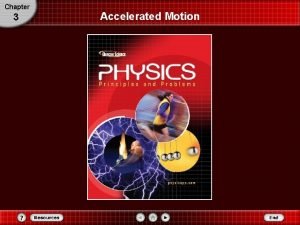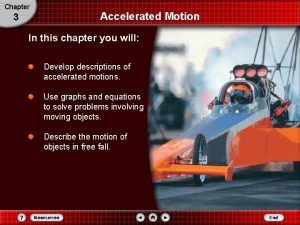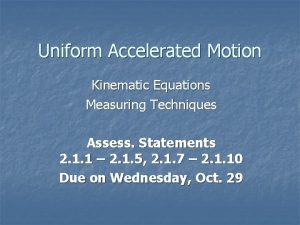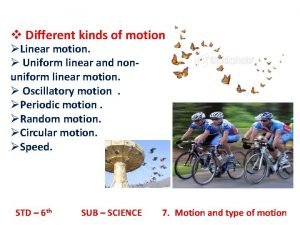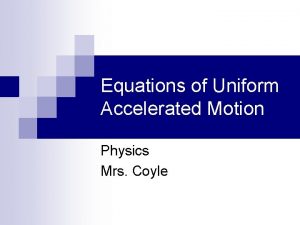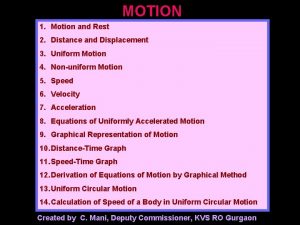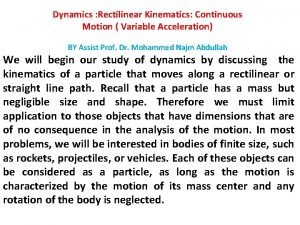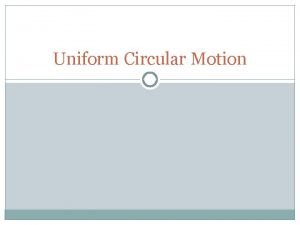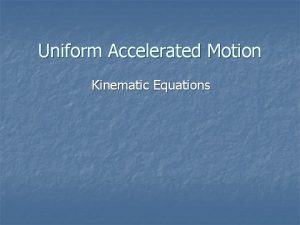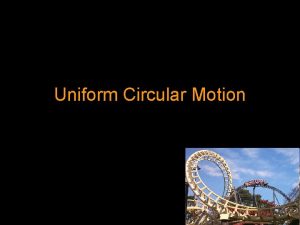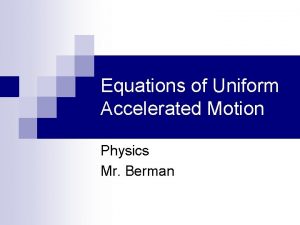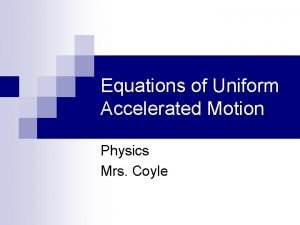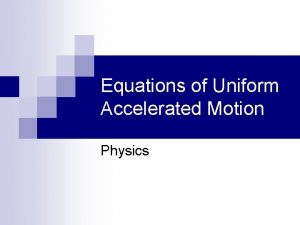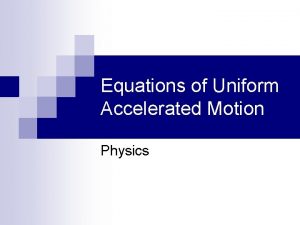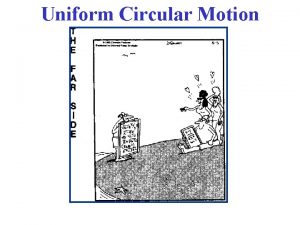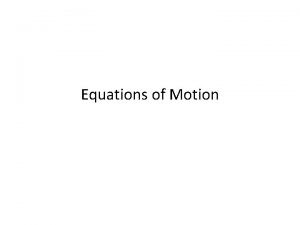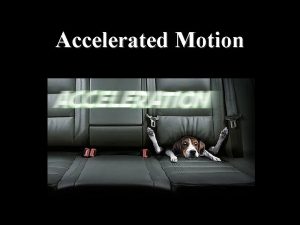Equations of Uniform Accelerated Motion AP Physics C















- Slides: 15

Equations of Uniform Accelerated Motion AP Physics C Mrs. Coyle

Uniform Accelerated Motion n Motion with constant acceleration q Straight line q Same direction

Equations for Uniform Accelerated Motion n Velocity v= vo+ at n Position x= xo + vot + ½ at 2 n v 2 = vo 2 + 2 a(x-xo) Remember: Displacement= Dx = x-xo

More Equations of Motion for Uniform Accelerate d Motion n vavg = n Dx n ½ (vo +v) = ½ (vo+ v)t Assume that ti=0

Example of Position vs Time (Positive Acceleration) Position (m) x= xo + vot + ½ at 2 Parabola o Time (s) Slope of Tangent at a given time= Instantaneous Velocity at that time

Example of Velocity vs Time (Positive Acceleration) v= vo+ at Velocity (m/s) o Time (s) Slope of Line= Acceleration Area Under Line=Displacement

Example of Acceleration vs Time (Const. a) Acceleration (m/s 2) o Time (s) Area under line = Change in Velocity

How do we derive Dx = ½ (vo+ v)t from the graph? Velocity (m/s) v vo o t Hint: Area Under the Line=Displacement Δx Time (s)

Example of Position vs Time (Negative Acceleration) Position (m) Parabola o Time (s)

Example of Velocity vs Time (Negative Acceleration) Velocity (m/s) o Time (s) Slope of Line= Acceleration Area Under Line=Displacement

Example of Acceleration vs Time (Negative a) Acceleration (m/s 2) o Time (s) Area under line = Change in Velocity

How do we derive x= xo + vot + ½ at 2 ? Hint: Start with Dx = ½ (vo+ v)t and then substitute for v that v = vo+at.

How do we derive v 2 = vo 2 + 2 a(xxo)? n Hint: Start with Dx = ½ (vo+ v)t then substitute for t = (v – vo) /a

Problem 1 A ball initially stationary, accelerates at 0. 25 m/s 2 down a 2 m inclined plane. It then rolls up another incline, where it comes to rest after rolling up 1 m. a) What is the speed of the ball at the bottom of the incline and how much time did this take? b) What is the acceleration along the second plane? Answer: a) 1 m/s, 4 sec, b) -0. 5 m/s 2

Problem 2 A Mustang travelling with a constant velocity of 35 m/s, passes a stationary police car. The reaction time of the officer was 2. 5 sec and he then accelerates at 5. 0 m/s 2 to catch the Mustang. How long does it take for the police car to catch the Mustang? Answer: 15. 8 sec
 Uniformly variable rectilinear motion
Uniformly variable rectilinear motion Chapter 3 accelerated motion answers
Chapter 3 accelerated motion answers Chapter 3 accelerated motion practice problems answers
Chapter 3 accelerated motion practice problems answers Rearranging kinematic equations
Rearranging kinematic equations Uniform and non uniform linear motion
Uniform and non uniform linear motion How to derive vf^2=vi^2+2ad
How to derive vf^2=vi^2+2ad Equations of motion higher physics
Equations of motion higher physics Uniformly accelerated motion formulas
Uniformly accelerated motion formulas Uniformly accelerated motion
Uniformly accelerated motion Comic strip showing uniformly accelerated motion
Comic strip showing uniformly accelerated motion Rectilinear motion with variable acceleration
Rectilinear motion with variable acceleration How do you classify uniform and non-uniform mixtures?
How do you classify uniform and non-uniform mixtures? How do you classify uniform and non-uniform mixtures?
How do you classify uniform and non-uniform mixtures? Contoh soal aliran seragam
Contoh soal aliran seragam Circular motion lab
Circular motion lab Uniform linear motion examples
Uniform linear motion examples

